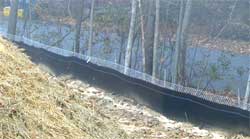There has been a lot of talk in the news recently about the damage caused by sediment on our lakes, streams, and rivers. While sediment comes from several sources including eroding stream banks, of particular concern is the amount of sediment escaping from construction sites.
- Go to the Fairfax County Erosion and Sediment Control Checklist
- Go to Land Conservation Awards for Excellence in Erosion and Sediment Controls
What is sediment and how does sediment cause damage to our properties and natural resources?
When land is stripped of grass, trees, and other plants, the soil becomes exposed and loose. Precipitation picks up the loose soil particles, which then get carried away in the runoff on its way to our lakes, streams, and rivers. When the flow of water slows down, the soil particles settle out as sediment. Sediment is the term used to describe soil that has moved from one place to another.
Sediment can be detrimental to the environment. Nutrients such as nitrogen and phosphorous that are attached to the sediment trigger algae blooms in ponds and lakes. Algae reduce water clarity, deplete oxygen, kill fish, and produce unpleasant odors. Excessive sediment blankets the stream bottom destroying the fish and other living organisms on the stream bed. Turbidity (muddiness) from the sediment impairs in-stream photosynthesis thus reducing the aquatic food supply and habitat.
Sediment also has an economic impact. Dredging ponds and lakes and restoring stream channels are costly and labor intensive. Properties adjacent to damaged water bodies can see their value affected.
What regulations do we have to prevent sedimentation from happening?
Each year an estimated 80 million tons of sediment are washed from construction sites into the lakes, rivers, and waterways of the United States. As more and more natural land is cleared for residential and commercial use, the chances increase for sediment to enter our waters.
The Fairfax County Erosion and Sediment Control Law addresses erosion problems on construction sites. This law requires that anyone who causes land disturbance exceeding 2,500 square feet must prepare an erosion and sediment control plan. The plan must satisfy certain minimum standards to reduce soil erosion and include practices to prevent eroded sediments from leaving the site. The appropriate authority within the County must approve the plan before land disturbance can begin. During construction, the project is subject to inspection to ensure that the plan has been properly implemented and maintained. If violations are found, the law provides for enforcement actions and penalties to be imposed.
With these measures in place, how does our present erosion and sediment control plan perform?
Unfortunately, inefficiencies exist and occasional failures occur. Sometimes erosion and sediment control plans are not adequately integrated with other stream protection measures such as stormwater management or land grading plans. The developer might not have adequately implemented the plan. And, most importantly, maintenance and inspection of the site might have been happened frequently enough. In fact, without adequate site inspection, even the best programs may fail. In highly urbanized watersheds like those in Fairfax County, frequent site inspection is very difficult because of inadequate manpower.
One proposed solution to inspection difficulties is to prioritize sites based on their environmental sensitivity, which can be determined when developers or owners apply for rezoning or seek plan approval. For sites that the County deems environmentally sensitive, the owners or developers would need to provide baseline, predevelopment information on downstream resources potentially threatened by the planned development. The County would inspect these sites more often. When runoff and sediment from a site cause downstream damage, the County could use the baseline data to assess the extent of the damage.
At present, lack of predevelopment information on damaged water resources is the main obstacle to reliable damage assessment.
What is the County doing to improve the quality of its erosion and sediment control program?
A steering committee appointed by the County’s Planning Commission is now examining several aspects of residential development in Fairfax County. The committee will review current policies and regulations regarding stormwater management and erosion and sediment control and their effectiveness in ensuring minimum impact of residential development on downstream properties. The committee is expected to come up with recommendations for improving the quality of the County’s erosion and sediment control program.
A separate county task force is reviewing the site inspection program to determine what it would take in terms of manpower and dollars to adequately inspect all building sites in the County.
The Land Conservation Awards are given each year to sites that demonstrate excellent erosion and sediment control design and implementation.
Erosion and Sediment Controls Found on Construction Sites: Pictures
Review the photos and methods below to learn more about erosion and sediment control practices.
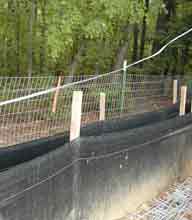
Silt Fence
A silt fence is a temporary sediment barrier made of woven synthetic filtration fabric supported by steel or wood posts. A silt fence should be installed below disturbed areas where erosion would occur in the form of sheet and rill erosion. It helps to contain sediment within the construction site. The bottom four inches of fabric must be buried beneath the soil surface to prevent sediment from going under the fence.
Double Silt Fence
The two silt fences prevent sediment from going into the tree save area, which is further protected by a chain link fence.
Super Silt Fence
A super silt fence has metal poles, spaced 10 feet apart, supporting a chain link fence. The woven synthetic filtration fabric is stretched across its length. A super silt fence is sturdier and less likely to be breached than a regular silt fence.
The super silt fence prevents erosion of the slope from affecting the stream below.
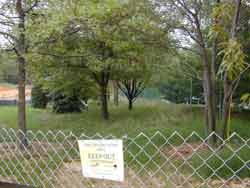
Tree Protection
No formal design is required, but several criteria must be considered to protect desirable trees from mechanical and other injury during land disturbing and construction activities. At a minimum, the limits of clearing shall be located outside the drip line of any tree to be retained and no closer than 5 feet to the trunk of any tree. Each tree to be saved must be marked at a height visible to equipment operators.
This is an unusual tree save area in that the trees were dug up and relocated by the builder for later replanting throughout the development.
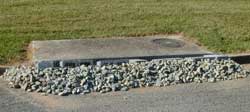
Inlet Protection
When storm drain inlets are to be made operational before the site is stabilized, they must be protected to prevent sediment from entering the storm drain system. Depending on the type of inlet, protection devices may include sod, concrete blocks, stone, wire mesh, filter fabric and/or silt fencing.
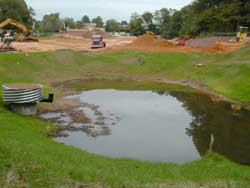
Sediment Basin
A sediment basin is a temporary impoundment (reservoir) built to retain sediment and debris with a controlled stormwater release structure. A sediment basin controls drainage areas over three acres with a maximum allowable drainage area of 100 acres.
The nicely grassed sediment basin prevents eroded earth materials from leaving the construction site. A sediment basin differs from a sediment trap in that it serves a larger drainage area (three or more acres up to 100 acres.)
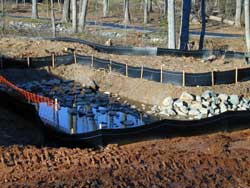
Sediment Trap
A temporary impoundment (reservoir) built to retain sediment and debris on a drainage area less than three acres. The sediment trap, on areas between one and three acres, is formed by building a predetermined reservoir confined by an earthen embankment with a pipe outlet. For areas less than one acre, a stone outlet is sufficient.
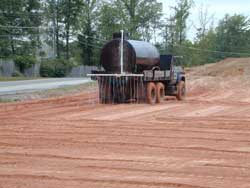
Watering Truck
Dust control is necessary in areas subject to surface and air movement of dust from exposed soil. Irrigation with a water truck is a common dust control practice.
The truck is spraying water from the back.
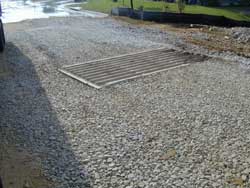
Construction Entrance
Whenever traffic will be leaving a construction site and moving directly onto a public road or other paved area, there must be a stone construction entrance lined with filter fabric to reduce the amount of mud being transported off-site. If conditions on the site are such that most of the mud is not being removed from the vehicles by driving over the stone, then the tires must be washed, and the waste water carried away to a settling area.
Vehicles stop at the wash rack to have the tires hosed off. The muddy water drains through the grates to the settling area.
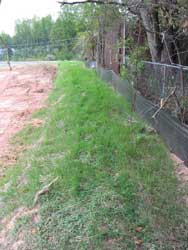
Diversion Dike
A diversion dike is a channel with a supporting earthen embankment on the lower side constructed across or at the bottom of a slope to intercept surface water runoff. Usually, the runoff is diverted into a sediment trap or sediment basin.
The nicely grassed berm keeps the runoff in the channel on site.
Slope Drain
Made of tubing or a another conduit of nonerosive material, a slope drain extends from the top to the bottom of a slope with an energy dissipater at the outlet end. A slope drain prevents off-site and/or onsite runoff from eroding a steep slope by containing the runoff as it goes down the slope. (No picture available).


